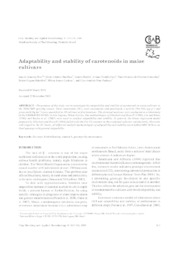Adaptability and stability of carotenoids in maize cultivars.
Adaptability and stability of carotenoids in maize cultivars.
Author(s): RIOS, S. de A.; PAES, M. C. D.; BORÉM, A.; CRUZ, C. D.; GUIMARAES, P. E. de O.; SCHAFFERT, R. E.; CARDOSO, W. S.; PACHECO, C. A. P.
Summary: The purpose of this study was to investigate the adaptability and stability of carotenoids in maize cultivars in the 2004/2005 growing season. Total carotenoids (TC), total carotenoids with provitamin A activity (Pro VA) (?g g-1) and grain yield (kg ha-1) were quantified in 10 cultivars at five locations. The chemical analyses were conducted in a laboratory of the EMBRAPA/CNPMS, in Sete Lagoas, Minas Gerais. The methodologies of Eberhart and Russell (1966), Lin and Binns (1988) and Rocha et al. (2005) were used to analyze adaptability and stability. In general, the linear regression model proposed by Eberhart and Russell (1966) failed to fit the Pro VA contents in the evaluated cultivars satisfactorily. However, with regard to the TC levels, all different analysis methodologies of adaptability and stability rated hybrid BRS 2020 as an ideal genotype with general adaptability
Publication year: 2009
Types of publication: Journal article
Unit: Embrapa Maize & Sorghum
Observation
Some of Embrapa's publications are published as ePub files. To read them, use or download one of the following free software options to your computer or mobile device. Android: Google Play Books; IOS: iBooks; Windows and Linux: Calibre.
Access other publications
Access the Agricultural Research Database (BDPA) to consult Embrapa's full library collection and records.
Visit Embrapa Bookstore to purchase books and other publications sold by Embrapa.

